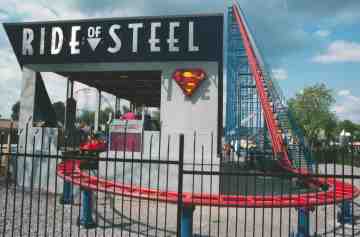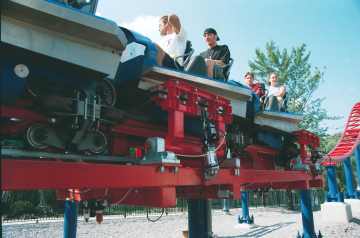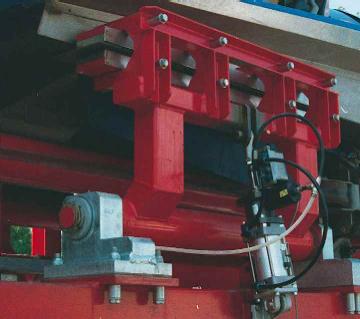
A similar ride at Six Flags Darien Lake
August, 2001 - Mega-Coaster brakes fail, trains collide
Sorry, you'll not find the definitive answer here. But this might still
be interesting.
And, no, there is nothing here about the rider who was ejected in May, 2004.
 A similar ride at Six Flags Darien Lake |
On August 6, 2001, two trains collided on the Superman: Ride of Steel coaster at Six Flags New England in Agawam, Massachusetts. That's the park formerly known as Riverside Park. Several riders in the two trains were injured, and the ride was closed for twelve days for an investigation. |
Now, roller coaster collisions are probably the most common of roller coaster accidents, in spite of the elaborate precautions taken to prevent them. Virtually all multi-train roller coasters employ some form of block control system to keep the trains safely separated from each other. You can read more about coaster blocking theory elsewhere on this site.
But while roller coaster collisions are not unknown, this particular collision has sparked more controversy and more discussion among ride enthusiasts and ride safety professionals than most. This is because unlike most roller coasters, Superman: Ride of Steel uses a revolutionary magnetic braking system thought to be virtually fail-proof. So when the brakes failed and two trains collided, the reaction among industry observers was swift and vocal. Could we really trust these high-tech braking systems? Had Intamin, the ride's manufacturer, pushed the envelope too far, allowing the train to come into the final brakes far too fast? Exactly what had gone wrong?
Now, before I go too far, I should mention that this is intended to be a discussion page, of sorts. I have never been to Six Flags New England, where the incident happened, and my knowledge of the braking system on the ride is based on my observations of a similar ride, Superman: Ride of Steel at Six Flags Darien Lake in Darien Center, New York, and of another Intamin ride with the magnetic braking system, Cedar Point's Millennium Force.
 A decent view of one of the brake calipers. Click for a bigger picture. |
Perhaps the best place to start is with a brief explanation of the magnetic braking system used on Superman: Ride of Steel. It's not too terribly complicated, actually. Two metal fins are attached to the sides of each car. The magnetic brake caliper consists of two powerful permanent magnets which interact with the moving brake fin. The moving brake fin generates a braking force which is proportional to the speed of the moving fin. This force slows the train to a near stop, but because the braking force is proportional to the speed of the moving fin, this force cannot reliably stop the train. A kicker wheel located at the downtrack end of the brake run is used to position the train and to stop it at the end of the block brake. According to Jeff Putz, webmaster at CoasterBuzz, the New England ride has six calipers on each side, a total of twelve brake calipers. The magnetic brake is extremely powerful, and will make it very difficult to move the train out of the block brake once it is desirable to do so. Jim Fisher did a back-of-the-envelope calculation based on some of his assumptions and concluded that moving the train at 5 ft/sec with the brakes closed would require 2,500 lbs. of force and would require at least a 30 HP motor, somewhat more force than the booster wheels can deliver. To solve this problem, Intamin mounted the brake calipers so that they could be pivoted away from the brake fins. Unfortunately I don't seem to have a photo of one of the brakes in the open position. |
One of the advantages of the magnetic braking system is that because the braking force is proportional to velocity, it is possible to use the system to bring a train moving at high speed to a near-stop in a very short distance. In the photo (above) you can see that the block brake is located right at the end of the ride's last steep drop. What is less obvious from the photo is that the brake run is scarcely any longer than the 8-car train. The stop is very fast, but offers almost no 'jerk' at all; the stop is a very fluid motion. This makes the magnetic brake one of the neatest roller coaster innovations since the tubular steel rail!
Another advantage to the magnetic braking system is that it is almost fail-proof. I say "almost" because, clearly, one such system did, in fact, fail. The brake caliper is counterweighted (you can't see it in the photo) to remain in the upright position. There is no physical contact between the brake fin and the brake caliper, so there is no mechanical wear. And the braking force is generated by one of those self-enforcing Laws of Physics. There really isn't anything there to go wrong!
For that reason, much of the early speculation focused on a catastrophic failure of the block control system. Perhaps there was a programming error that allowed a block violation. Maybe it was a sensor failure. Maybe the control computer hiccupped. On the Internet discussion boards, the result was a lot of discussion about component failure detection, failsafe logic design, and the importance of fault-tolerant logic.
Meanwhile, Six Flags Theme Parks' reaction to the incident was uncharacteristic of the chain. In the past, when a ride similar to a Six Flags ride has suffered a breakdown, Six Flags has typically taken the cautious approach and shut down any ride they have that is even remotely similar so that if changes are required to insure safe operation, those changes can be made. In this case, Six Flags owns three very similar roller coasters, all called Superman: Ride of Steel, all with the same magnetic braking system. The ride that failed is at Six Flags New England; the others are at Six Flags America (previously Adventure World) in Largo, MD., and at Six Flags Darien Lake in Darien Center, NY. But after the New England Superman crashed, not only did the other two Superman coasters remain open, they continued to operate two trains! Those of us who were watching with interest knew that the cause of the incident had to be known, and had to be simple, or else the other two Superman coasters would have also been closed, or at least limited to single train operation. It is, after all, very difficult to have a collision with only one train on the track [Footnote 1].
| On Saturday, August 18, 2001, Superman: Ride of Steel re-opened at Six Flags New England after an investigation conducted by Six Flags staff, Intamin representatives, and a State of Massachusetts representative who had no legal jurisdiction over the ride but was invited to participate anyway. According to published news reports, and according to the park's official press release (right), the cause of the accident had been a blown air supply hose on the ride's braking system which prevented the brake calipers from functioning properly. This, of course, has brought about another flurry of discussion about how such a simple, single-point failure could cause such an accident. Six Flags has replaced the original plastic air lines with steel-reinforced air lines and re-opened the ride. Meanwhile, those of us on the outside, now that we know the incident was caused by a blown hose, are studying the braking system in greater detail, trying to figure out just what went wrong. | Here is the official press release from Six Flags New England explaining the results of the investigation: |
| SUPERMAN
RIDE OF STEEL RE-OPENS AT SIX FLAGS NEW ENGLAND
Experts
Complete Review For Immediate
Release - August 18, 2001 At the close of an extensive twelve-day review, safety experts and engineers from Six Flags and the ride manufacturer as well as independent experts concluded that a series of factors triggered by one primary event combined to contribute to this highly unusual occurrence. "These findings are the result of an extensive review by a team of safety experts who closely examined every facet of the operations and systems of this ride," said Tim Black, Vice President and General Manager, Six Flags New England. Safety experts and engineers determined a ruptured air supply line disrupted airflow and air pressure levels in the primary braking mechanism further preventing the full engagement of the backup brakes. Even so, safety engineers calculated the backup brake mechanism operated at 60 percent, slowing the train to less than 20 MPH as it entered the station. Safety experts outlined and implemented four safety modifications for the ride to ensure this event never happens again, including:
"The deliberate approach to this review rendered several safety modifications," said Black. "Although the addition of the steel reinforced air supply line would have been sufficient to prevent a reoccurrence, safety experts also added three additional safety measures." The ride along with the additional safety modifications underwent a rigorous testing and certification process prior to the re-opening of the ride today. The ride was cleared to open by safety engineers and experts. |
|
| Press release supplied by Dean O'Keefe, Marketing Director, Six Flags New England |
 The magnetic brake caliper. Click for a bigger, clearer image. |
This photo is a detail of the shot above, showing one of the magnetic brake calipers on Superman: Ride of Steel at Darien Lake. This was the first of the Superman coasters to open, and I shot the photo during my visit in 1999, the ride's first season. It appears to me that the white line is the air supply line, coming from what appears to be an oil injector, visible below the track in the larger photo. It couples to the tee connector and the black hose which appears to be connected to a solenoid valve actually mounted on the actuating cylinder. The air lines coming off of the solenoid valve are connected to both ends of the actuating cylinder, and this may be key to understanding why a loss of air pressure could cause the brake to fail instead of allowing the brake to simply return to its "set" position under the influence of the counterweight (not visible in the photo). It appears that the cylinder is fed pressure at both ends so that it can be forced into either the "set" or "released" position. This suggests that perhaps the counterweight is not itself enough force to reliably haul the brakes into the "set" position when the top of the cylinder is full of compressed air. So the solenoid valve is used to switch the brake between its open and closed position, and either way air pressure is needed to make the cylinder move. It stands to reason that a blown air supply hose would cause a pressure drop in the system that could reduce the effectiveness of the actuator cylinders on the other calipers in the circuit as well. |
More than one person has suggested (Iain Hendry probably gave the most complete description) that the solenoid valve on the brake caliper is probably designed so that the single pressure input is diverted to either of the two outputs, and the other output port is simply vented. The valve has an "energized" and a "non-energized" position; it stands to reason that the non-energized position would feed air to the bottom of the actuator cylinder, venting the top of the cylinder and extending the rod to "set" the brake, while the energized position would vent the bottom of the cylinder and feed air to the top of the cylinder, retracting the rod and pulling the brake "open". That way, if electrical power is lost, the brake would go to full-set provided that compressed air is still available. Since the air supply probably comes from a pressure tank, it is likely that a loss of electrical power will not immediately include a loss of air pressure. But if the air supply line is cut, the cylinder will be able to vent on both sides...on the inactive side through the exhaust vent in the solenoid valve, as usual, and on the active side through what is supposed to be the air supply line. The air pressure in the cylinder would quickly equalize, and the cylinder would no longer offer any significant resistance to movement in either direction. So the caliper could easily open up.
I still have questions about this, though. First of all, I would expect the caliper to be fairly stable...that is, once set, the caliper should stay set until the cylinder is shifted. Remember, the caliper is counterweighted to stay "set". phil, a CoasterBuzz contriubutor, described an incident on Superman: Ride of Steel at Darien Lake (the ride shown in my photographs) where the mounting bracket for one of the actuating cylinders broke, making it impossible for the pneumatic cylinder to move the brake caliper. The counterweight was enough to hold the brake "set" as the train came in, so the train stopped without incident. Knowing that, I'd think a loss of air pressure should have caused the counterweight to reset the brake.
Next, why did a loss of supply air pressure to one caliper prevent other calipers from setting? Is there not more than one pneumatic circuit for the block brakes? The photograph of the Darien Lake ride suggests that there is a separate regulator and lubricator for each pair of calipers. But the SFNE press release notes (Corrective Item #4) that separate control valve assemblies were installed for each pair of brake calipers. I presume this refers to what I thought to be a line regulator on the Darien Lake ride. This implies that all six pairs of brakes were fed from a common pressure source, meaning that one blown hose would cause at the very least a pressure reduction in all of the calipers. This seems to be a potential design flaw, one that Six Flags fixed after the accident.
I also wonder about the references to a "backup brake mechanism" described in the press release. The magnetic calipers are the only obvious mechanism used for stopping the train, so I don't think that refers to additional braking hardware. That suggests that it must refer to alternate engagement means for the magnetic calipers. There is a black canister attached to the bottom of the solenoid valve, connected through a tee fitting to the air supply line. I have not been able to determine what that part is, or what it does, but I wonder if that is the backup device mentioned in the press release. Eric Breault suggests that since the canister is upstream of the solenoid valve, perhaps it is a pressure transducer to detect a loss of air pressure. That makes sense to me except for two minor details. First of all, I don't see any electrical connection to the canister, so if it is a pressure transducer, either it connects directly to the solenoid valve, or it has some mechanical role to play. Second, the press release (remember, I'm assuming that the brakes at Six Flags New England are similar to the ones at Darien Lake) indicates that a pressure monitoring system was installed as part of the post-incident retrofit. The photos on this page were taken in 1999, during the Darien Lake ride's first season of operation. But it is an interesting thought. Eric's comments gave me another idea: Perhaps the tee connector contains a one-way check valve. In that case, the black canister could be a backup pressure tank for the cylinder. I'm not entirely convinced, but it seems like a possibility.
Since I started this project, I paid a visit to Cedar Point and took a closer look at the block brakes at the end of Millennium Force. That coaster also uses a magnetic braking system, and it was built by Intamin AG, the company that built Superman: Ride of Steel. But I noticed that the braking system on Millennium Force is different from the system pictured above on the Darien Lake ride. First of all, Millennium Force has a long brake run flanked by fixed magnetic brake calipers which trim off most of the train's speed before it reaches the block brake. Only the block brake has the moving calipers. Second, there are no counterweights on the Millennium Force block brake calipers. Third, the cylinders operating the brakes are much larger than the ones on the Darien Lake ride, and are connected to the air supply conduits via large hoses with braided covers, not the thin plastic hoses seen in the Darien Lake photos above. Next time I go to Cedar Point I'll take a camera and see if I can get some decent photos of this mechanism. My suspicion is that the cylinders used on Millennium Force may be spring-return cylinders rather than double-action cylinders, but that is mere guesswork on my part.
If you have any insights or more detail to offer, I encourage you to email me, and I will include your observations on this page.
--Dave Althoff, Jr.
Footnote 1: Difficult, but not impossible. Some years ago, for instance, Geauga Lake managed to have a collision with only one train on their classic Big Dipper wood coaster. It seems a coupler spring broke on the drawbar between cars, and allowed the cars to crash into one another on the brake at the end of the ride. [Back to text.]
Created 08/20/2001.
Last content update 08/21/2001, 5:25 pm EDT
Minor revision, 05/06/2004